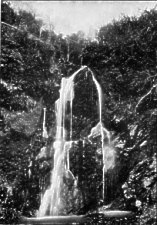
Dhoon Falls
[From Handbook En Route, 1899]
The first reach is down the valley to the north head of Laxey Bay. The finest views in Lonan are from this section : the wooded vista of Glen Roy; Cairn Gerjol beyond; the wall of hills; and the coast towards Douglas.
The second reach is by the coast, north, a steady ascent through the Abbey Land farms. The seaward spur from Creg Agneash, bounding Lonan and Maughold, has its coast abutment in a notch-like indentation called Bulgham Bay, famous for most excellent shell-fish. The promontories of Maughold are seen in echelon.
The old road is inland over the ridge ; the modern road, like the famous Corniche Road, being quarried through the scarped cliff 400 feet above sea-level. To carry the line round this point a deeper cutting into the hill was conceded for the road, the line taking the old waybed on the edge of the cliffs.
Once round the turn, there bursts into view a superb prospect of mountain, ravine, and sea- cliff. Heather above, green farms below- descending to ravines that broaden and deepen into a wooded gorge that plunges out of sight down to the sea.
Beyond the gorge, seawards, is a dome of rock sparsely clad with gorse and heather, and sprinkled with erratic boulders of granite. This is the Barony Hill, once belonging to St. Bees Priory, dimly visible thirty miles away on the coast of Cumberland. The cliffs of slate strata set on edge are full of mica, and in the sun- shine glitter like silver. Beyond this prospect is North Barrule, its ridge by an air line some three miles away-ever on "watch and ward," the sentinel of Maughold at its feet. It is necessary to visit the Dhoon Falls. The air is filled with the rush of cascades and the wash of waves. The path descends zigzag, following the gliding and plunging torrent. Timber grows all the way down. One moment we look over the summits of pines, the next moment our heads pass level with their roots. The great fall makes two leaps of 60 and 70 feet respectively ; and there are many lesser cascades.
Ferns and moss flourish in shade and spray. Grass trails over the banks. Festoons of ivy dip into circling pools and sway on glissades of pure dark water. The Dhoon shore is suggestively reminiscent of the days of smuggling.
Dhoon granite is equal to the best Dalbeattie or Aberdeen. Paving sets and road mineral of excellent quality are produced at the quarries near the line. This granite has hard wearing qualities. The quarries only need developing to become a valuable industry for the locality. Further on, the next seaward hollow descends to Glen Mona. On the left is Creg-na-Mult (Wether Crag) ; on the right Dhoon Church, a chapel-of-ease to Maughold. Here the line sweeps (right) coastwards ; the road skirting the mountains to meet the line again at Ballure.
The high road crosses Ballaglass river at the Corony, a delightfully picturesque spot-bridge, mill, smithy and cottages all on the banks of the river. This is the birthplace of the Poet Kennish, author of " The Melliah " (Harvest Home) and " Oiel Verry " (Christmas Eve).
The upper valley west to Slieu Ouyre (1,809 feet) is a magnificent solitude. Its streams have excellent trout, very little fished. In this glen are mines, connected with Laxey by workings underneath the mountains.
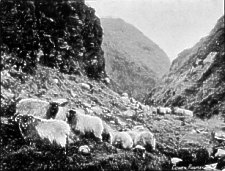
Park Llewellin
An ancient burial-ground and cross dating from Scandinavian days are on the North Barrule side of the glen. The ridge above - an immense sheep run - is Park Llewellyn, broken by un- suspected ravines and gullies, where flourish the blackthorn and mountain ash.
The area of the Island is 227 square miles, or 145,000 acres, just 60 per cent. of which is cultivated, leaving 58,000 acres of waste and mountain. The cultivated limit is about the 700 feet line of altitude. Snaefell rises to 2,034 feet, North Barrule 1,850, and Slieu Ouyre 1,809. In the southern district the loftiest summit is South Barrule, 1,545 feet, or 300 feet lower than North Barrule Old documents invariably call these mountains " fells "--a word no longer used on the Island, as it is in Cumberland.
Returns give about 60,000 sheep --chiefly pastured above the line of cultivation.
Besides heather and dwarf gorse the following somewhat rare plants are found on the heights : yellow mountain violet, mountain everlasting, heart-leaved twayblade, heath fern, oak fern, moon-wort, dewberry, black crowberry, split-moss, fork-moss, hairless-moss, several varieties of hair-moss, thread-moss and feather-moss-one variety of the latter occurring. nowhere else in Britain except in Teesdale, Yorkshire and in County Kerry.
The characteristic flowers are : in Spring, the primrose and (celandine) buttercup; later, the daffodil about every farmstead ; on every hedge-row a blaze of golden gorse; and, in the glens, the white sloe.
The hawthorn blooms late, with pink and white dog-roses, and myriads of little scentless violets. In Summer the purple foxglove is everywhere. In Autumn the upland heather and dwarf gorse suffuse the air with colour.
The Island is extraordinarily rich in flowers -that is in quantity ; for the number of distinct species is not quite 500. But with such mild winters the fuchsia grows luxuriantly out of doors ; and gorse flowers all the year round.
The Electric Railway crosses the river half a mile below the Corony Bridge. The Power Station is beside the river near the culvert. Two magnificent engines, each of 180 h.p., with Ledward condensers, coupled to immense Edison-Hopkinson multipolar dynamos, generate the electricity which is received by an accumulator battery in an adjacent block of buildings.
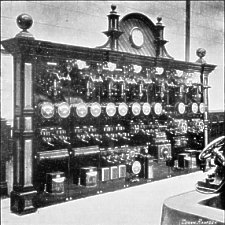 Electric Signals, Ballaglass |
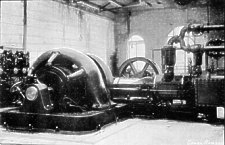 Multipolar Dynamo |
("FOLK-LORE." A. W. Moore, M.A.)
In Maughold the Manx tongue survived till quite yesterday: and all the old people can still speak it on occasion. Legends, curious customs, superstitions, ballads, carols, songs, and fragments of songs, constitute the " literature " of the Island of the past. But the proverbs of Manxland best indicate the Manx mind.
Slaa sahll er toion muck roauyr, " Smear grease on the fat pig's rump." Moyll y droghad myr heu harrish, " Praise the bridge when you are safe over." Siyn follym smoo sheean nee, " Empty vessels make most noise. " Ta lhane klinkyn ayns car-y-phoosee, " There are many twists in the wedding song."
Cynical distrust and practical caution ! " Credit will come to get paid ! " " Soon ripe, soon rotten ! " " Eaten food is forgotten ! " The Manx fisherman's toast is famous :- Bioys da dooinney, baase da eeast, " Life to men, death to fish!" Yn raad mooar Ree Goree, " The great road of King Orry, " means the Milky Way.
Characteristic phrases indicate an effective brevity in Manx speech: Lhiam lhiat, " With me, with thee," is said of a double-faced person ; Ta cheet lesh, " it comes with him, " of a prosperous. There is a touch of gentle feeling in : Goll sheese ny liargagh, " Going down the slope " -spoken of one in failing health.
The station for Ballaglass is by the culvert. The beauties of this glen are embraced in half a mile of forest-like woods-the beeches being exceptionally beautiful trees. The bedding of the slate strata here shows immense flat surfaces ; platforms and ledges projecting over the waterworn pools and miniature canons of the river. Vast detached blocks lie about, tenderly broidered with moss and laced with luxuriant fern. The falls are a series of cascades infinitely varied through the whole ravine.
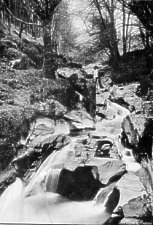
Ballaglass Glen
The disused lead mines on the edge of the woods are a familiar feature of Manx glens. The Island furnished lead to Edward I. for his Castles (Caernarvon, Conway, etc.) in Wales ; and to John Balliol for Cruggleton Castle in Galloway, six centuries ago. There are traces of these old workings ; and of still earlier, that go back to prehistoric times. They are rude surface scratchings, when contrasted side by side with the mines of Laxey which are of enormous depth-362 fathoms or 2,172 feet- as deep below sea-level as the summit of Snaefell is in height above it ; and with workings that pass underneath the mountains between the valleys of Laxey and Ballaglass.
Every Manx glen has its legend of the water- sprite. In Ballaglass is the Phynodderee Gorge, believed to be the haunt of this being of the Manx imagination. The old Manx song " Berry Dhone " is also associated with Ballaglass.
Of all the glens on the Island, this was the favourite of the late Rev. T. E. Brown, the National Poet of Manxland, author of " Fo'c's'le Yarns " and " Betsy Lee." He used frequently to walk out from Ramsey, to stroll and loiter and dream in the glen-lingering on till evening, and walking home in the starlight.
On the summit of the Rhenabb Hill (" District of the Abbey "), westward above the glen, is a stone circle known as Castle Gorry (or Orry), the estate being called Ballagorry, or the Manor of Orry. The circle is incomplete ; but what remains of it, and the situation, well repay a half-hour's walk. 45
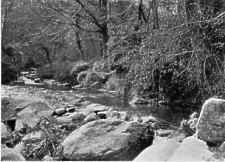
At Cornaa
At the foot of Ballaglass the river is crossed at a most picturesque ford and foot-bridge, by the old road dating from the day of the saddle and the pack. A mill, grey with age, powdered with mill-dust and lichens, and with ferns dripping in its wheel-pit, nestles down by the river below the ford. Cornaa Mill is of great antiquity, being mentioned in the Rent Roll (1513) as the property of John McCristen of Milntoun, Deemster and ancestor of Iliam Dhone, the " William Tell " of Manxland-executed (1662) for raising the Island in arms during the Commonwealth.
In a cottage on the old road, a little way west of the ford, the old Manx hand-loom is still in use. It is almost the last survival of what was once an important industry. Up the hill past the cottage is the way to Castle Gorry, and to the head of Glen Mona, which is also accessible from Port Cornaa.
The valley from the mill to the harbour is open and sunny, with straggling woods and pretty little meadows along the river-the best bit of water on the Island for sea-trout.
The Barony Hill, west of Port Cornaa, was formerly called the Barony of the Hough. It belonged to the Priory of St. Bees ; and has still the ruined Barony chapel on its summit.
The electric telegraph, indicated by the line of posts skirting the base of the Barony Hill, joins a submarine cable to St. Bees.
Port Cornaa has no houses about it, and wears an air " of pastoral melancholy." It formerly had a fleet of fishing boats in the days when the Maughold farmers followed the herring fishing in boats of their own ; and the cottages of the fishermen who sailed with them were dotted over little country crofts and clustered by the river on Port Cornaa.
The following notes on Rainfall, Temperature, and Sunshine, are taken from the Annual Meteorological Reports of the Isle of Man Natural History and Antiquarian Society, published in the Society's journal, and contributed by Mr. A. W. Moore, M.A., J.P., of Cronkbourne.
| RAINFALL. | |
|---|---|
| Point of Ayre | 24.6 inches. |
| Douglas | 41.1 |
| Ramsey | 41.6 |
| Bishopscourt | 40.5 | /tr>
| TEMPERATURE. | |
| Highest Shade (1887) | 81'4° |
| " Sun(1878) | 141 '0° |
| MEAN MAXIMUM SHADE (20 YEARS). | |
| May | 57'2° |
| June | 62'5° |
| July | 63'8° |
| August | 60'7° |
| September | 54'0° |
| SUNSHINE. | |
| The annual average (18 years) was | 1,594.3 hours. |
| The warmest year (1887) gave | 1,822.7 |
| The least sunny(1888) | 1,453.6 |
Here the Manx climate is seen in a very favourable aspect, as these figures show that it has more sunshine than any other place in the United Kingdom in a similar latitude.
The Glen Mona stream is a tributary of the Cornaa, meeting it a quarter of a mile above the Port. Its pools still bear the old designation, linga (--- a pool). The Phynodderee Gorge in Ballaglass has its counterpart in the Linga- glashtin, or pool of the glashtin (water-horse).
The characteristic note of Manx glens is tenderness. In the tiniest ghyll with its rivulet, and in the great glens of Groudle, Glen Roy, Laxey, the Dhoon, and the Corony, there is this note of exquisite tenderness. But Glen Mona is unique : it is colonial, foreign, tropical. The festoons of ivy-single pendants from the tree, broad valances over the rock-have a richness and exuberance of beauty peculiarly its own. Its beauties are also curiously hidden, re- vealed with a succession of surprises, and the delightful sense of discovery,-as if no eye had ever looked on them before.
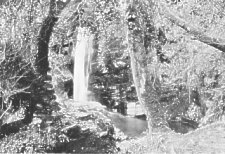
Glen Mona Fall
An absolute stillness is everywhere in the seclusion of the woods, broken only by the a muffled boom of the falls and water-breaks.
Maughold Parish extends from the Dhoon to Ramsey. It abounds in Norse names and other vestiges of the hardy Vikings who ten centuries ago made the Island their new home. From Ballaglass Station the line rises sea- wards to the spur that terminates in the cliffs east of Port Cornaa. The views are superb. The Cornaa is down below on the right, veiled in the bewitching, tantalizing beauty of its woods. The magnitude of North Barrule now makes itself felt impressively. The southward coast- precipices, buttresses and bastions of an iron- bound land-lies in retrospect : and the eye seeks to trace in succession points of the route by which all that way has been traced.
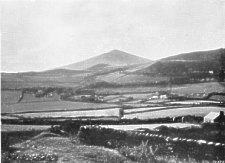
North Barrule from Maughold
When the line bends north on the ridge, the coast and its farms glide behind us. The gradient sharpens. It is a continuous descent of some five miles to Ramsey, Maughold Head comes into view : and at that point among the fields on the left is a plot of ground called Ruillic-ny-Quakeryn, or the Quakers' Churchyard.
The Friends came here about 1650, and made converts among the people. William Callow of Ballacallow, a leading proprietor, became a Quaker. In 1665 he was imprisoned in Peel Castle for religious contumacy, and , banished from the Island. Prince Rupert interceded for him with the Earl of Derby ; but in vain. The exile married a Quaker heiress of great wealth-a Miss Warland, of Oxfordshire. Through failure of heirs, the estate passed into Chancery; and has never been recovered. The collateral descendants, heirs of this now immense wealth, have settled in Oregon, U.S.A.
The crossing at Ballajora is the most convenient station for this romantic spot, as also for excursions along the Port Mooar coast and for Maughold church.
|
|
||
| |
||
|
|
||
|
Any comments, errors or omissions gratefully received
The Editor HTML Transcription © F.Coakley , 2008 |
||